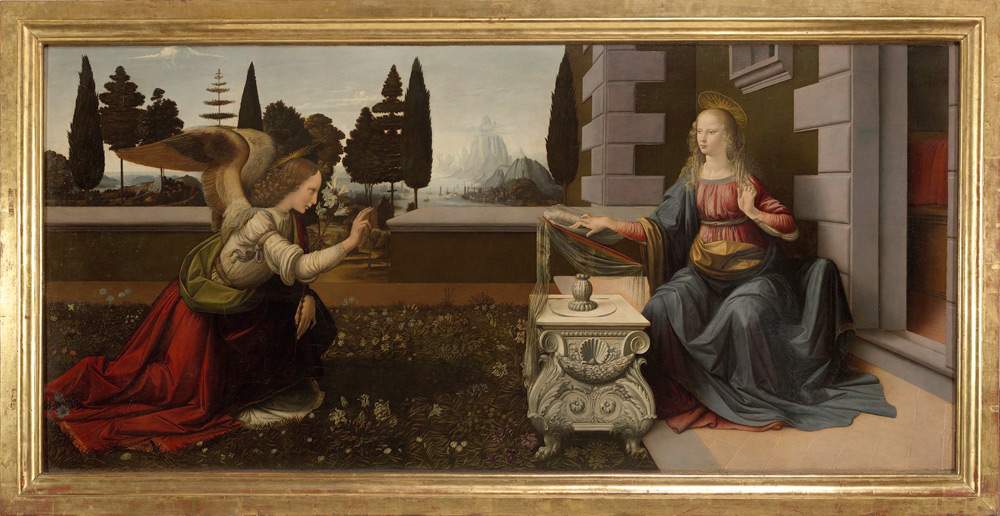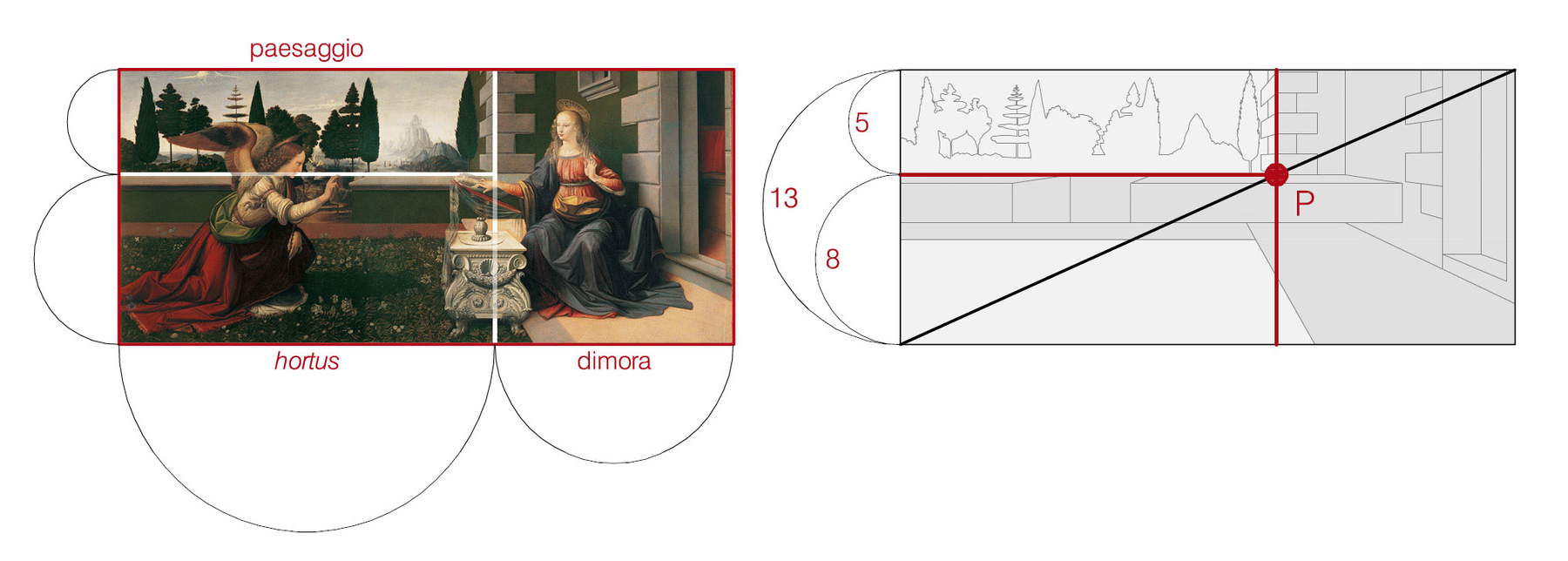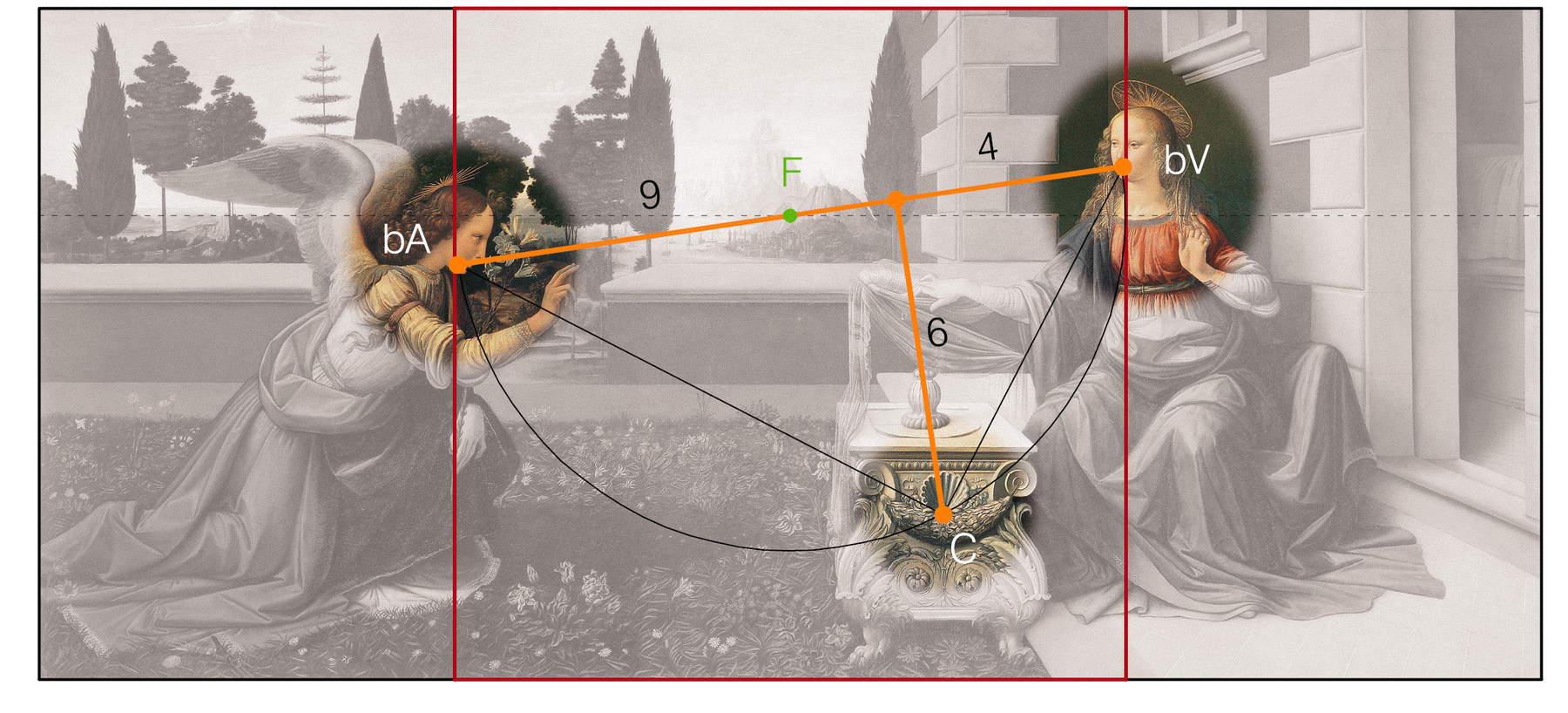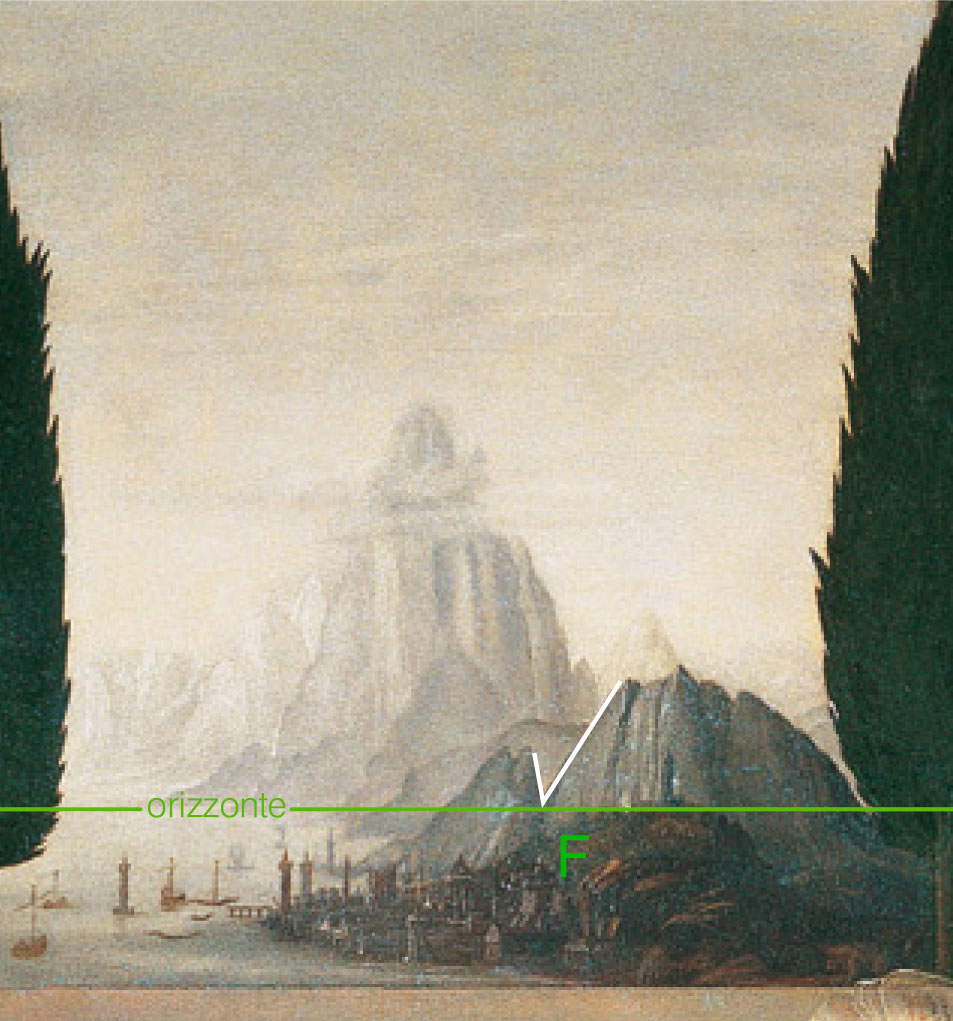Is it appropriate to propose, today, new points of view to analyze a work by Leonardo now so much travelled, investigated and only recently attributed? Or is it instead guilty carelessness not to have searched so far, beyond the usual reading, for its mathematical components, when it is known that "the master pursued all his life the resolution in numbers of his extraordinary images"1?
The Florentine panel exerts a real fascination on the observer: not so much for the expressiveness of the characters, but for the unprecedented cut of the scene that offers an unusual and new proposition of the theme of the Announcement, for the rigorously calibrated interweaving of the scores, for the selection of spaces thoughtfully dosed according to geometric canons. The figures play on planes of balance that tend to further dilate the already pronounced horizontal development; the trees (a long theory of different essences) follow one another at an accelerated pace: twelve (the tribes of Israel?), but one (the tribe of Judah from which the Messiah is born?) deliberately and emblematically next to the dwelling, to leave an open gap where the landscape recedes according to the aerial perspective that would be theorized by Leonardo. Here, at the base of the mountain split, is the vanishing point of central perspective, fixed at the intersection of the two diagonals that determine the painting’s golden scan.
The format of the panel is reason and occasion for such virtuosic composing. Leonardo, with a particularly shrewd choice, adopts it to narrate the mystery of the Incarnation. Not an original option, if you will: the same formula is used a millennium ahead for the plan of the Parthenon and will be used five centuries later for the canvas of Guernica.
If the outline of the golden rectangle that inhales the divine proportione is well known, not so well known is, however, this formula that sums up two complementary golden rectangles and multiplies their potentialities through proportional tracings. Pacini will clearly represent them, drawing them from the treatise in which Gino Severini describes the harmonic composition of the mosaic of the Palazzo delle Poste in Alessandria2. Leonardo uses them to give continuity, coherence and unity to the scene and the protagonists. Subtending, beyond the image, an interweaving of signs and symbols, propositions and figurations, or even provocative enigmas that constantly run through the work. Encrypting, however, the numerical values, which he inevitably had to dispose of to scan the steps, the links, the pauses of the warp. Although he does offer a key to interpretation and, we shall see, one that is consistent with the theme.
 |
| Leonardo da Vinci, Annunciation (c. 1472-1475; oil and tempera on panel, 98 x 217 cm; Florence, Uffizi) |
 |
| Landscape, hortus and dwelling are arranged in a geometric pattern that defines their relationships according to perfect proportion. The two perpendicular lines, bench of the wall and edge of the dwelling, intersect at a focal point that connects the scores: above the stated message of the 5 dangling stones |
The 5 of the Pentateuch, visualized in the corner ashlars
The8 of theoctava die, concealed but measurable in the section that follows
The 13 of sacrifice and redemption, summing them up in the height of the table
Where did Leonardo get this particular formula? From the workshop secrets handed down within the guilds, or from the manuscript version of the Dere3 that circulated in those years. Alberti counts it among the ideal areas with the diction double sesquialtera or double diapente, because of the always timely match between lengths and musical intervals. It is more properly expressed by the ratio L/L √5 between the sides. What, in the coeval units of measurement, were the dimensions of the table, what were the dimensions of the architecture built on the picture plane, what were the distance ratios between the figures, has been an age-old rovello for us.
The habit of professionally intervening on historical factories, surveying their values, and transposing them into the local system of measurement has led us to look with the same optics at this vincian work, which, even at first glance, suggests preordained geometric archetypes.
The vexata quaestio of the intuitive gesture guiding the hand in the maker or, vice versa, of an upstream canvas, does not arise forarchitecture: in the discipline where the use of measurements is obvious, one always senses a logical, linear, consequent tracing, peculiar to the artist and his time. To be found today in the face of the complex problems pertaining to the recovery of the great works of the past, where the ability to express a current lexicon in a historically established context is required. As if to say that (if the mode of rectareinproportione has been lost over the centuries) the first act of a responsible exegesis would be to search for it in the factory itself to the point of understanding the syntax, the norm, the rule that preside over its identity. A methodology of approach that also applies to the figurative arts, to this vincian work, for example.
After all, Leonardo, too, often waits with sketches and drawings for architectural proposals,4 and his works arise precisely in the historical period in which the science of numbers is the prerogative of artists who move in the wake of Piero della Francesca, who are schooled in the treatises of Alberti and Pacioli, who create with the practical-applicative aid of the now codified Fibonacci progression. The Pisan mathematician’s series is precisely what this early work draws on, although the values can only approximate the exactness of the geometric construction.
In search of this order, measuring carefully like the surveyor of Revelation5, moved our study of the Annunciation6.
On the plane of the panel two orthogonal lines (the pallet of the little wall and the edge of the dwelling, which the eye stretches beyond the painted line) define the essential warping. Visually stated and judiciously placed they select in golden ratio the spaces to which they compete; their intersection is at a focal point on which the three planes of the narrative converge. Since the scene is classically tripartite (landscape, hortus and dwelling) the different fields are arranged according to a punctual and allusive plot on which the characters converse.
Strongly marked, the five corner ashlars, “those ashlars (so resentful, but decorative, and not functional) almost as if they were designed especially to guide our gaze like arrows, ”7 take on an unusual prominence, out of scale with respect to the architectural context. An actual anomaly, although not such for the author, who favors their number and not their size (“the stone discarded by the builders has become a cornerstone,” Psalm 118:22).
Only long after our initial approach, and with sudden insight, did the very corner stone prove to be the unit of measurement, and thus the key to understanding the work. With the acquisition of the metric reference pertaining to the scene, it was possible to give entities of magnitude to all the parts. Thus emerged, above the point of connection, the 5 units declared by the ashlars; their number relates to the 8 units of the section below and, necessarily, to the sum 13 (height of the table chosen by the author or more likely imposed) according to the Fibonaccian succession.
The same values underlying Leonardo’s painting are visualized in architecture: recall the 5 and 8 bays on the minor and major sides in the cloister of the Real Collegio del Patriarca in Valencia and again the 5 and 8 bays per side in the 16th-century small and large cloisters of San Pietro in Reggio Emilia8. Numerical choice reiterated, in this case, by their pitch of 5 and 8 arms.
A sort of “rule of art” of ancient knowledge, a practice that holds, in the modularity of the figures, harmonic consonances and, in the magnitude of the values, theological content. Again a triplet of numbers appears in the path of the dialogue. The appropriately angled line between the mouths of the protagonists, nearly equal to the height of the table, stands as the diameter of a semicircle that has its center at the vanishing point. The perpendicular vector that divides it into the sections 4 and 9 (between which the ratio √5 runs instead) turns out to be 6 and refers punctually and emblematically to the Marian symbol of the shell on the side of the portal board. But 4, 6 and 9 are precisely the partitions indicated by Alberti to compose, from the square with later additions, the double sesquialtera format.
On folio 23r of Manuscript K Leonardo proposes a similar right triangle, identified by exactly the same values: an encouraging confirmation of the author’s hand.
The reading of the vincian table, for those who deal with its mathematical aspect, is thus already oriented by the same perimeter definition. Taking it apart, or rather disassembling it, was like peeking into the master’s secrets and attempting to delve into the mind of genius.
Through the repeated use of the formula √5 Leonardo focuses the Story at the moment of the Announcement, in the words of the Angel, whom Mary welcomes inside herself and into the space of the dwelling: a new Ark of the Covenant, like the biblical one of Exodus9, defined, in turn, by golden relationships. Geometry and numerology establish themselves as unusual new parameters for broader exegesis.
 |
| Leonardo da Vinci, Manuscript K, f. 23r (Paris, Institut de France) |
 |
| The semicircle, with center at the vanishing point, passes through the mouths of the characters and through the shell on the side of the portaleggio |
 |
| The vanishing point is at the base of the mountain rift |
Notes
1 E. Garin, Universality of Leonardo, in Science and Civic Life in the Renaissance I, Rome-Bari, in A. Perissa Torrini, The Enigma of Harmonious Man. Leonardo’sVitruvian Man, Art and dossier no. 256, June 2006.
2G. Severini, Le nombre d’or et d’autres rapports d’harmonie dans l’art moderne (1951), in Dal cubismo al classicismo, reprinted by P. Pacini, Florence, 1972, p.229.
3L.B. Alberti, De re aedificatoria, book IX, ch. V.
4 On the subject C. Pedretti, Leonardo architetto, Milan, 2007.
5 Rev. 11:1.
6 F. Manenti Valli, Leonardo, the harmonic composing in the Annunciation panel, Cinisello Balsamo, 2012.
7 A. Natali, Doubts, difficulties and misunderstandingsin Leonardo’ s Annunciation, in Leonardo’s The Annunciation. La montagna sul mare, Milan, 2000, p. 45.
8 Cf. of the A. Beyond Measure, the language of beauty in the Benedictine monastery of San Pietro in Reggio Emilia, Modena, 2008.
9 Ex. 25:10.
Warning: the translation into English of the original Italian article was created using automatic tools. We undertake to review all articles, but we do not guarantee the total absence of inaccuracies in the translation due to the program. You can find the original by clicking on the ITA button. If you find any mistake,please contact us.